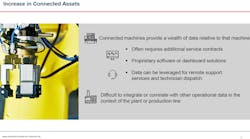During the live Q&A portion of the webinar, "Remote Monitoring: Replace Instinct with IIoT Insights to Improve Equipment Efficiency," Chris Lebeau, global director of IT for Advanced Technology Services, Inc. (ATS), and Paul Miller, principal analyst for Forrester, discuss the importance of IIoT.
PS: For companies that struggle to implement a strategy around digital transformation, do you have any advice on the first steps they can take to move in that direction?
CL: Digital transformation is very much a buzzword and the question is, what does the digital version of your business or your plant look like? The first thing to take a look at, the conversation I've had with a couple of customers about this is, "Where are your inhibitors to smooth operation? Is it common breakdowns? Is it analysis of your overall maintenance costs? Is it availability to parts?" Then use these data to really drive where you need attention, and then take a look at how those things are addressed from a process perspective. Often a digital transformation is nothing more than a business process improvement exercise with better tools and better information about the processes being executed. It can be more complicated than that. In essence, it's in its most basic form.
PM: I would add: listen to your customers. Find out what they think the pain points are in their engagement with you. What do they wish you would do differently? What new thing do they wish you would do that you haven't been doing? Do not necessarily assume the customer is always right and therefore do anything, but listen to them, reflect on why they're saying what they do, and have a very serious internal conversation about whether or not the company needs to change direction a bit or possibly dramatically. Then, take advantage of data-driven, insights-driven opportunities to do that. The thing you think you valued for might not be valuable to your customers anymore, so don't assume that it is.
CL: That's true, Paul. The internal view of digital transformation was where I went with my answer, and the external piece is equally important. For example, if you look at General Electric with jet engines, they sell you an engine and then they used to sell you maintenance services. Now they sell you jet propulsion as a service and they're monitoring that engine to determine when and how they do work to it. So, is there a digital complement to whatever it is you manufacture or offer your customer? And then how do you basically present that data and deliver that?
PM: Absolutely.
PS: What is the most effective strategy for monitoring and coordinating all the sensor data to drive an action? Do you use a call center for this or something similar?
CL: The commonality of how we collect the data is really the key part. We try to establish a framework that we can feed data into. When you're working with a new solution or potentially integrating with somebody else's sensor solution, there's a little bit of work to do there. But getting all the data into one consistent format allows our centralized resources.
We have a 24/7 monitoring center, called Reliability 360, and there's a variety of different types of expertise that operate in that center on behalf of our customers. But giving them one view across all of those plants significant advantage, right? Where there's machinery, they can begin to do correlations and understand different types of breakdowns or commonalize repair parts and, you know, minimize inventory.
The key thing is that they see all the sites the same way, at least in terms of that incident model that I outlined. What conditions equal an incident that somebody needs to react to? The first use of the data is obviously for somebody local, if something's hot or going to fail, somebody locally needs to be notified because they're physically the ones that can do something about it. But what assistance might they need? If we know that part likely has failed, can somebody initiate a part order on their behalf? Can they initiate OEM support? Can they do a variety of other different things to assist the person as they deal with that issue? That's really the role of the Reliability 360 Center, and the resources that are there are designed to be helpful to the people on-site and to coordinate on their behalf to make whatever it is that they're doing easier and more efficient.
PS: How does increasing product life by manufacturers differ from that of maintenance? What’s the difference between having someone from the OEM side come in and conduct maintenance based on data they're receiving remotely versus your normal plant-based PMs?
PM: There's a place for both, frankly. A lot of it will come down to the complexity of the asset, the way in which the asset was sold. For example, Chris talked about GE and the jet engines. It may be that actually the product is delivered to the customer and the customer is not allowed to maintain it because it will void warranties, or it will induce penalties if the manufacturer or their agent aren't doing that maintenance on their behalf. There's contractual material to think through, absolutely. Once you get past that, there's a place for both and real value in both. And a lot of it will come down to exactly what the relationship between you and your manufacturer and you and your service teams looks like.
